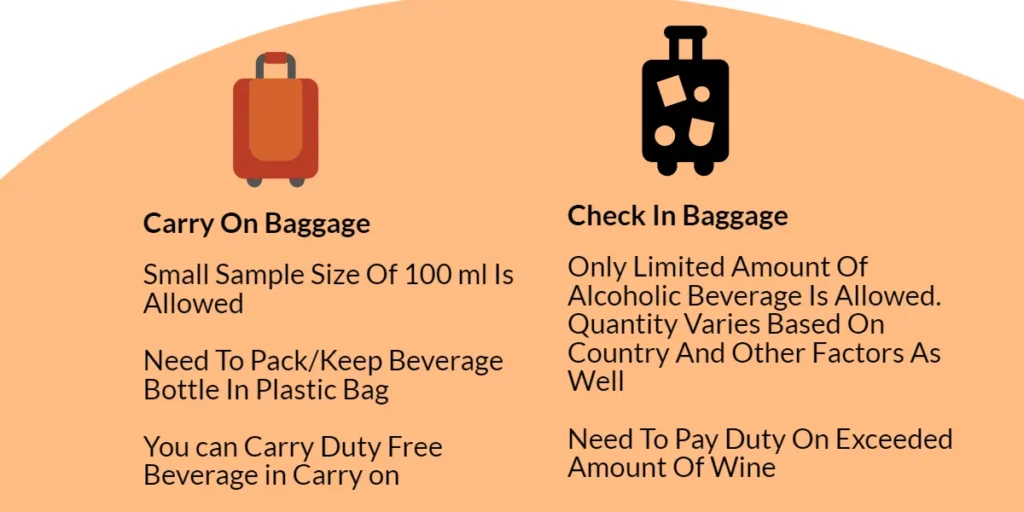Thousands of people travel through airlines from various countries and experience different tastes and cultures. For adults, wine/beverages of the respective country would be top on the bucket list.
Alongside the United States, Spain and Italy are among the top producers of wine and alcoholic beverages. Some aged wines could be pricey, while others are known for their unique test.
Most people also bring their favorite beverage in their home country for themselves or relatives. In the article below, I have explained how to pack wine in luggage along with an essential guide and regulations.
How To Pack Wine In Luggage?

How To Pack In Check-in Baggage?
Wine bottles may get broken if not properly packed in a checked-in bag.
Usually, most people put a wine bottle in a single sock and then wrap a thick cloth around it like a sweater to make a padding surrounding the bottle.
Again, put thick wine-wrapped cloth in the center of other clothes. The objective is to prevent the bottle from colliding with another glass bottle or getting hardly impacted while in transit and eventually rapture.
Another downside of wrapping clothes is that it becomes a hassle and risky when customs officers check your bag.
For a few bottles, you can use a reusable Vinni Bag, which is inflatable with a mouth, creates enough relaxing space around the bottle, and protects it from damage. If the bottle breaks, it is unlikely to spill and ruin clothes.
However, other wine bags in the market have different designs and are not as reliable as the Vinni Bag mentioned above.
If you have multiple precious wine bottles, consider a separate wine suitcase like VinGardeValise. It has built-in foamy wine molds to carry up to 4 to 12 bottles, depending on size.
A separate wine suitcase may be a costlier option than the above, but it secures multiple fragile bottles at once and makes life easier at the airport.
Is It Allowed To Take Wine In Carry-on Luggage?
Only a tiny sample bottle size of 100ml/3.4 oz is allowed in your carry-on bag, and it must fit comfortably in a quart-size bag to prevent it from spilling in case of bottle breakage.
The TSA requires passengers to pack their carry-on toiletries or liquids in a quart-size bag.
The only other way to carry bigger bottles (less than 24% alcoholic content) into the cabin area of a plane is by buying beverages from the duty-free shop in the airport after security clearance.
TSA Guideline For Carrying Wine In Luggage
A person can only carry wine in checked baggage, and in the US, each person can carry up to 5 liters of liquor if the alcohol percentage is between 24% and 70%; it must be unopened in retail packaging, and you must not pack an already opened alcohol bottle as it is flammable and hazardous.
There is no specific limit mentioned on the number of beverages with an alcohol content of less or up to 24%. In either case, you need to declare the amount of wine you are carrying, otherwise you may get charged with penalties.
Any beverage with over 70% ABV(alcohol by volume) is not permissible by airlines.
TSA Guideline For Passengers On Wine
TSA recommends people double-check the alcohol policy of the respective airline they are flying. That person(with alcohol) must be 21 years old; make sure you do not violate the state laws in which you are landing.
Passengers are not allowed to drink alcohol while on board until or unless served by the flight crew. Furthermore, the flight crew may not serve alcohol to already drunk persons.
US Customs Department On Carrying Wine In Luggage
The custom duty applies to the worth of the item you have bought, and each person has an $800 worth of custom duty exemption. In case of wine more than a liter, you will be charged 3% of its cost per liter.
However, there are certain conditions you should keep in mind, like where you are traveling and in which state you are landing. Travelers coming from the Caribbean or the Virgin Islands are allowed to bring more alcoholic beverages than the usual person.
Each state has a different law for wine and usually updates it occasionally. Visit their site to check the updated policies of each state regarding beverages you are bringing.
Wine from duty-free shops within airport premises won’t be taxed in your departure country. On the other hand, you might have to pay duties on the exact wine in the destination country.
For example, if you have bought wine in Europe from a duty-free shop, then on the return, you have to pay taxes in the US if you have more than 1 liter of beverage per person.
Tip: If you have a family member of allowed age, you can use his/her name to bring another liter of bottle duty-free.
Fun Fact: Did you know that if you purchase a bottle of wine from a duty-free shop in the United States, take it with you to Canada, and then bring it back to the United States, you may be required to pay customs or IRT taxes if the bottle is more than one liter? It’s an interesting fact to keep in mind if you’re planning to travel with alcohol.
Wine Guideline By Australian Border Force(ABF)
According to the Australian Border Force, people aged 18 or above can bring 2.25 liters of alcohol, approximately two bottles of wine, and you must declare it.
You may bear additional penalties if you did not declare any item like wine or bought it in exceeded amount quantity. For beverages in bulk or in larger quantity, you may need to require a certificate to bring and sell them for commercial purposes.
Domestic flights have no limit on the amount of liquid, aerosols, and gels you can carry in your check-in baggage. They also have a similar policy for taking beverages in your carry-on, including a 100ml container within a sealed plastic bag to avoid spills.
Cabin beverages container must be 100ml even if it is filled less than that. A container of more than 100ml is not allowed in your carry-on bag.
What Could Happen To Wine/Beverage While Air Travel?
There is little detail to be added, possibly a slight change in taste. As you may know, suitcases are rigorously handled, turbulence shakes occur in the cargo area, and the temperature rises on long flights in warm regions.
These small factors might not cause significant differences, and it is something to keep in mind for wine lovers.
The Bottom Line
In conclusion, navigating the world of traveling with wine involves careful considerations, from packing techniques to understanding airline regulations and customs duties.
Whether you’re bringing a taste of your home country or indulging in the flavors of your destination, this guide provides essential insights for wine enthusiasts on the go.
Remember, each country and state may have its own rules, so staying informed is critical. Cheers to seamless journeys and unforgettable experiences.










